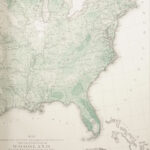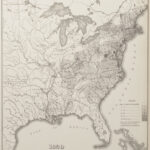Published: New York, 1874
At MIT, we know Francis Amasa Walker as the Institute’s third president and the namesake of Building 50, but few realize how versatile and prominent he was even before taking the helm at MIT. Walker was a veteran of the Union Army, a newspaper journalist and editor, Chief of the Government’s Bureau of Statistics, superintendent of the Ninth (1870-1872) and Tenth (1879-1881) United States Censuses, Commissioner of Indian  Affairs, and professor of political economy and history in the Sheffield Scientific School of Yale University before coming to MIT as President. It’s quite a list of achievements to carry out by age 41.
Affairs, and professor of political economy and history in the Sheffield Scientific School of Yale University before coming to MIT as President. It’s quite a list of achievements to carry out by age 41.
 It was in his capacity as Superintendent of the 1870 census that Walker oversaw the production of the Statistical Atlas of the United States, the first American national atlas and the first comprehensive thematic atlas produced by any nation. The atlas compiled maps, graphs, statistical tables, and essays by scientists, economists, and government officials, and it was a pioneer in the visual and cartographic depiction of statistical information (you might think of it as a very distant ancestor of GIS and the red- and blue-coded maps always on the news around election time). Part I of the atlas included – in the fashion typical of atlases of the time – maps of the physical features of the United States. In Parts II and III, the thematic maps of “Population, Social and Industrial Statistics” and “Vital Statistics,” along with pathbreaking graphs such as pie charts, were true innovations. With federal funding, copies of the atlas were delivered to school, colleges, and libraries across the United States as the country geared up for its centennial celebration.
It was in his capacity as Superintendent of the 1870 census that Walker oversaw the production of the Statistical Atlas of the United States, the first American national atlas and the first comprehensive thematic atlas produced by any nation. The atlas compiled maps, graphs, statistical tables, and essays by scientists, economists, and government officials, and it was a pioneer in the visual and cartographic depiction of statistical information (you might think of it as a very distant ancestor of GIS and the red- and blue-coded maps always on the news around election time). Part I of the atlas included – in the fashion typical of atlases of the time – maps of the physical features of the United States. In Parts II and III, the thematic maps of “Population, Social and Industrial Statistics” and “Vital Statistics,” along with pathbreaking graphs such as pie charts, were true innovations. With federal funding, copies of the atlas were delivered to school, colleges, and libraries across the United States as the country geared up for its centennial celebration.
 In a section called the “Progress of the Nation, 1790-1820” the atlas presents a set of maps, using data from previous censuses, that demonstrate the “imperial sweep” of United States population settlement across the land, with the names of Native American nations disappearing as the wave progressed to the West. It is interesting viewing in light of Walker’s belief, stated elsewhere, that “The westward course of population is neither to be denied nor delayed for the sake of all the Indians that ever called this country their home. They must yield or perish.” The atlas also contains maps depicting the concentration of Americans with “foreign parentage” and the “foreign-born.” Although he believed that the original inhabitants of North America should give way to the Western European immigrants, Walker was an outspoken proponent of immigration restrictions on Southern and Eastern Europeans. He was the author of a theory, later discredited, that the arrival of immigrants depressed the birthrate of the native-born population, thus holding the overall population steady while increasing the proportion of immigrants.
In a section called the “Progress of the Nation, 1790-1820” the atlas presents a set of maps, using data from previous censuses, that demonstrate the “imperial sweep” of United States population settlement across the land, with the names of Native American nations disappearing as the wave progressed to the West. It is interesting viewing in light of Walker’s belief, stated elsewhere, that “The westward course of population is neither to be denied nor delayed for the sake of all the Indians that ever called this country their home. They must yield or perish.” The atlas also contains maps depicting the concentration of Americans with “foreign parentage” and the “foreign-born.” Although he believed that the original inhabitants of North America should give way to the Western European immigrants, Walker was an outspoken proponent of immigration restrictions on Southern and Eastern Europeans. He was the author of a theory, later discredited, that the arrival of immigrants depressed the birthrate of the native-born population, thus holding the overall population steady while increasing the proportion of immigrants.




